The 6 Pak, Grand Rapids’ Legendary All-Girl Rock Band
by Kim Rush
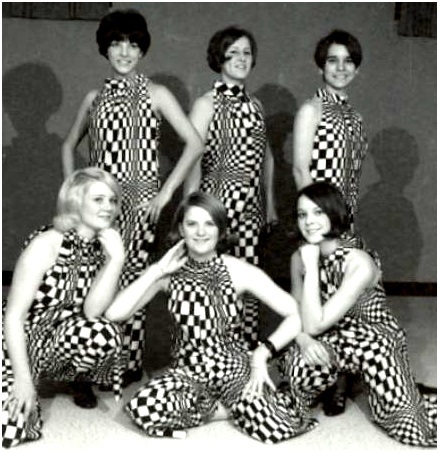
There were several notable female singers who performed and recorded in the Grand Rapids area during the 1960s. [see footnote at the bottom of this article] However, it was not until 1967 that our local music scene enjoyed the novelty of an all-girl rock band.
Six West Catholic High School sophomores created the 6 Pak in early 1967. Their drummer, Cindy Grey Obetts, suggests that “because we were girls we got all kinds of breaks.” Bass player Rochelle Geluso Mudrey concurs, “We were definitely unique. People were very curious about an all-girl band. It brought the boys out to hear us. We got all kinds of publicity because we were girls. We were teenagers, still living at home, with no heavy responsibility. Our parents allowed us the trust and freedom to do something fun like this.”
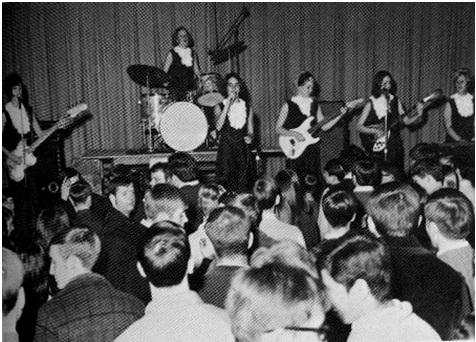
No shortage of boys at this 6 Pak dance
However, other all-girl rock bands existed in various parts of the United States. Among the earliest to obtain a recording contract were Goldie and the Gingerbreads.
The 6 Pak visited ‘The Place’ on Plymouth N.E., in Grand Rapids, to meet with another fellow all-female Michigan band called The Pleasure Seekers. This group included Suzi Quatro, who a decade later provided the role of ‘Leather Tuscadero’ for the Happy Days TV show.
Rhythm guitarist Mary Arbanas: “We had a good music department at West Catholic. We were surrounded by music all the time. It was a big part of our lives. We all belonged to St. James church youth group, as well. We all had a deep appreciation for music.”
Cindy explains how the band got started: “Drummer Steve Mosketti lived across the street from me. We attended grade school together and became close friends. I used to watch Steve’s band called Stix and Stones rehearse and they would visit me at my parent’s house. One day Steve gave me a broken drumstick. I took it home and started working out rhythms on my pillow!”
Keyboard player Andrea Halas Sullivan began playing the piano when she was in third grade. She also knew the accordion. Andrea invited her good friend, Mary (Arbanas) to join the 6 Pak. Mary’s father served as her primary musical influence, as he played the tamburitza, a Croatian instrument which resembles a mandolin.
Cindy invited her close friend, lead guitarist Karen Delehanty, to join the new band. Karen was definitely the quietest member of the band. Mary recalls that “she always had a smile on her face, didn’t talk a lot, and had a beautiful voice. Cindy adds: “she played a mean guitar. We never knew when she was going to break into an instrumental solo during the middle of a song, which was really spontaneous and fun. She would always smile while she was playing a solo. When we learned a new song and it had a lead guitar solo, she would go home after practice and study it. By the next practice, she pretty much had it down pat. She was really good at that.”
Rochelle: “my dad loved the accordion and was my biggest fan. I owe my love of all types of music to him. He was my teacher, but I also took accordion lessons at Wendlandt’s music store on West Fulton Street.” Mary suggests that “Rochelle was a natural. She just picked up the bass and started playing well.”
Cindy: “I wanted to play the drums so bad! My dad was a drummer, too. I became obsessed with drumming from watching Steve play and I knew I just had to do it, too.” Opportunities for the band to perform at the Guest House on Stocking Avenue and a talent/variety show at St. James School surfaced in April. “We knew there were no other girl bands around so we just thought it would be neat to give it a try. We borrowed some of Stix and Stones equipment for our first few jobs. There wasn’t much else to it. None of us made a big deal out of it. But once we had played in public we all discovered that it was so much fun that we wanted to go further with it. We were all hooked. So we realized that we had better get busy and learn some more songs for our next job.”
Mary recalls, “though we practiced almost every night, it was never a chore. It was not like that. We were like sisters. We had so much fun! There was no competition, even though our singer, Marcia, and the bass player, Rochelle, attracted most of the boys.” The band members still agree that there was very little dissension. The musical arrangements were contributed by all group members and no one tried to dominate the band.
Initially, they began practicing in Cindy’s parent’s basement. Once they had acquired their own equipment and Paul Arbanas became involved, they moved their rehearsals to a small room located near Mary’s parents’ living room. Eventually, the equipment was stored and practice sessions were held at Danny Brown’s house. Evening practice sessions lasted until 9 or 10 P.M.
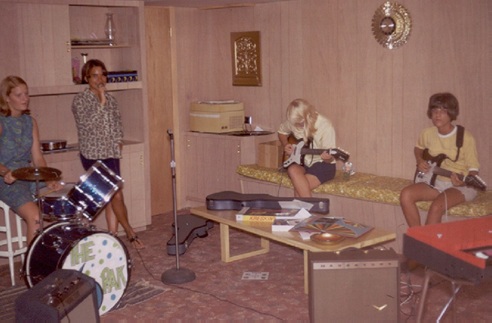
Summer of 1967 practice session in Cindy’s basement. Left to right are Cindy, Marcia, Karen and Rochelle. Andrea and Mary were present, but are not captured in this photo. (courtesy of Jerry Panek)
The girls thoroughly enjoyed each other’s company on a social level, in addition to their musical camaraderie. They double dated, went to the beach and shopped together, as well as attending parties with each other.
St. James School staged their talent show during April of 1967. Cindy’s father created a “6 Pak” sign for the band to display on stage. Their first few jobs were school and church related. By May, honor student and glee club member Marcia Boruta became the lead vocalist for the band. Mary and Andrea invited Marcia to join the band. They had all been friends since grade school. Music played a part in Marcia’s family, too. Her mother played the piano and the whole family loved to dance to Polka music.
Marcia’s first job with the 6 Pak was at a Holy Spirit Church Auditorium dance. Local D.J. Bill Merchant was the M.C. for the event. The girls shared the stage with another local band called Reasons Why. This band included Pat O’Brien, Paul Gray, Vince Palazollo, and Denny Kaminski. Rock groups were springing up everywhere in Grand Rapids during the middle and late 60s, including other bands from Grand Rapid’s west side, such as The Mafia and Joe Banana and the Bunch.
Steve Mosketti helped Cindy learn how to play the drums and loaned her his drum set for the 6 Pak’s first jobs. Cindy: “Steve’s whole band helped us, but it was primarily Steve and Dan Purdom. We were eager to learn from anyone that would help us.” Mary recalls that Dan, the guitarist for Stix and Stones, was in her biology class. “Dan drew illustrations of chords on the neck of a guitar for me, just like Mel Bay chord books, and I’d take them home and learn them.” Another musician named Pat Kozak also helped Andrea with her keyboard technique.
All of the girl’s parents were supportive of the band. Mary’s parents contributed generously. They loaned the band money for equipment and allowed them to use their new station wagon for hauling this equipment to their jobs. Mary’s older brother, Paul, served as manager. Danny Brown, a close friend of Paul’s, always travelled with the band, assisting with the driving and hauling of equipment. He drove Mr. Arbanas’ station wagon every weekend that they had a job. Karen and Cindy rode with Danny and the equipment while Mary, Rochelle, Marcia and Andrea rode with Paul in his Thunderbird.
Andrea’s parents owned a grocery store and meat market and donated food for the band when they had to drive a long distance or performed out of town, including pop and snacks and plenty of other good things to eat.
The 6 Pak fashioned their own outfits to wear at their performances. Most of these were jumpsuits made with various colors and patterns, including one created of purple velvet with white- laced collars. Marcia states that “one of our outfits was a shiny blue fabric, but there wasn’t enough blue material available for six outfits, so my outfit was green. So I acquired the nickname ‘Peter Pan’ because of that outfit. We also had some publicity photos taken in my parents’ basement where we were wearing black and white checked outfits.” They made lighter outfits for the warm summer months. Band members often wore black ‘flats’ with their uniforms, which were in style at that time.
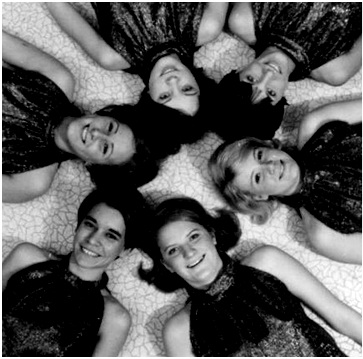
6 Pak publicity photo
Teenage Nightclubs and the Lowell Showboat
The jobs that the 6 Pak secured in the summer of 1967 through manager Paul Arbanas and “word of mouth” were higher profile engagements that were coveted by other established bands. There was competition between the various bands for these quality gigs, and the 6 Pak occasionally encountered some jealousy. Many of these bookings were located at teenage nightclubs, which were extremely popular in the 1960s.
These “clubs,” or more accurately, teenage dance venues, existed in many Michigan towns, both large and small. They began to appear more predominantly during the early popularity of the Beatles and Rolling Stones, often referred to as the British music ‘invasion.’ There were a few teen nightspots in the Grand Rapids area that predated the peak period of the teen clubs. The Eschelons worked at the Skyline in the Morton Hotel in 1959 as well as at the Bluebird, in Ada, in 1960. Guitarist Mick Noonan also played at The Tones at 5110 West River Road, before it burned down, in the early 60s.
The 6 Pak worked at several popular teenage nightclubs around Michigan including the Platters, Johnny’s Bandstand, the Sweet Note, Club Ponytail, Shelby Pavilion, and the Teen Chalet. They also performed locally at the Phoenix Position, at 44th and Kalamazoo S.E., and the 25th Hour on Pearl Street.
While they were at the Platters, the house disc jockey challenged the girls to learn the Rational’s version of a song that Aretha Franklin made famous, called “Respect.” He didn’t think they could do it. He gave them the recording and they learned their own version of the song. When they returned for a later engagement at the Platters, the DJ was totally impressed with the 6 Pak’s new edition of this song and he finally displayed the respect that was due to them.
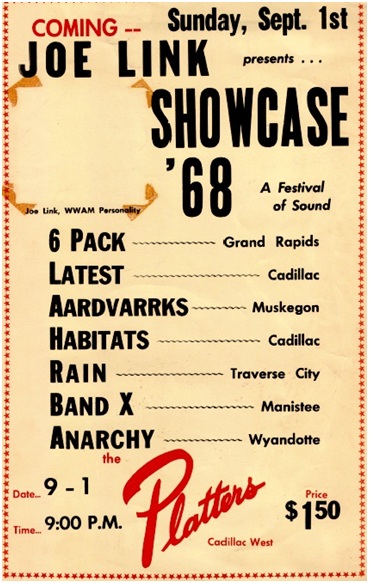
The 6 Pack performed on Sunday, September 1, 1968 at Platters in Cadillac
Tonto and the Renegades drummer, Tom Kirby, also performed at many of Michigan’s teenage nightclubs: ”The popularity of the Beatles and the British music ‘invasion’ had a lot to do with the multitude of bands that came into existence in the 60s. Teenagers needed a place of their own to congregate. These kids felt the same pressures as their siblings that were older than them. There was the fear of nuclear war and being drafted into the Vietnam War. There were various other problems and turmoil going on around us like the Cold War, assassinations, riots and war demonstrations, and a general distrust of government. The kids needed an outlet from all the scary, unsettling stuff that was going on.”
“There was also big money to be made for the teen club owners. The kids poured into these places and wanted to hear the good bands. But eventually they got tired of the teen ‘scene,’ abandoned these clubs and started getting into other things, such as drugs. The music was constantly changing, and it changed again in the late 60s with the new psychedelic music. For a few years the clubs were as fresh and exciting as the new music.”
In the 1960s, many American teenagers were questioning the values of their parents and the older generations, as well as political and military leadership. Seemingly inexplicable and fear-invoking events were occurring such as the Cuban Missile Crisis and the assassinations of President Kennedy, Robert Kennedy, and Martin Luther King. There was a growing suspicion among some young people that the American public was being misled. The questioning themes of some rock and roll lyrics, though often inane, addressed and reinforced this perplexed and untrusting mindset.
A general relaxing or ‘loosening’ of social and religious values, which escalated in the 60s, also served to provide an increasing tolerance and acceptance for the “new music” which had originated only a decade before. Many parents eventually began to agree to allow their teenagers to assemble regularly in the teenage nightclub settings, even on school nights. Although there were teen rock and roll dances in the 1950s, they were usually restricted to weekends and were more tightly supervised.
Regardless of the change and uncertainty surrounding them, the 6 Pak’s positive attitude and composure remained unscathed. Mary: “Life was so simple for us then compared to what it’s like now for kids. We lived a sheltered existence. We all had a good solid Catholic upbringing. None of our parents were divorced. I guess it was a lot like the ‘Leave it To Beaver’ TV show.”
By the summer of 1967, local rock bands including the Headhunters (from Lowell), the Chevrons and the Fugitives (from Grand Rapids) and Black Watch (of Cedar Springs) had heard the 6 Pak at their practices or their engagements, or shared the same stages. A few of these musicians had become friends with the girls. Their paths were crossing throughout this summer. In August the Chevrons and the 6 Pak sat together during a talent contest in Lowell, which the 6 Pak won. The girls also worked at the 25th Hour on Pearl Street with the Chevrons, during this same month. On August 18th they worked with the Headhunters in Freeport. They were on the same program with Black Watch at a dance in September as well as the Grand Haven Beach Bash during the following month. During September, Black Watch members showed up at a 6 Pak practice session and taught them “I Can’t Keep from Crying,” by the Blues Project. Cindy: “It was not as simple as the rest of our songs but we thought it was cool to play it.” That same month, they also worked with another Grand Rapids band called The Aardvarks. This engagement was at the Platters, which was located near Lake Mitchell, in Cadillac. They finished out the year by working with the Chevrons, again, at the 25th Hour, in December.
Marcia Boruta recalls the excitement of these times: “our band was a really great experience for me. While many teenagers were cruising up and down the circuit on Monroe Avenue on Friday and Saturday nights, we were working at a really cool ‘job.’ The most important thing I realized from this experience is that it’s not the performers who make a performance great, it’s the audience. I mean, I can sing really good walking down the street, but a crowd of 500 teenagers having a good time is what really created the positive energy.”
In July of 1967, the 6 Pak auditioned to perform for the Lowell Showboat celebration. The auditions were held at the downtown WZZM -TV studio. Legendary jazz pioneer Louis Armstrong was the headliner. He performed for a few nights, with the opening acts provided by local talent. On August 12th, the 6 Pak performed before Armstrong and his band. They met him and his band that same evening, which also included Jewel Brown, who sang with Armstrong from 1961-1968. He was very pleasant and signed autographs for all of the girls.
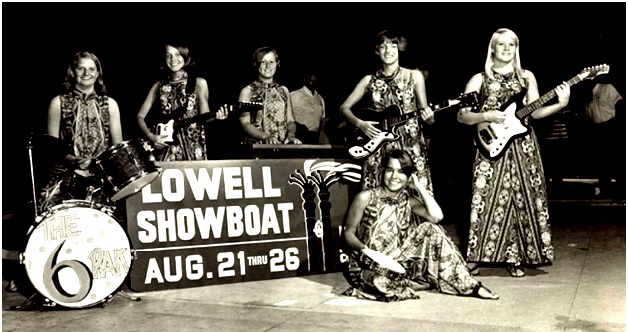
The 6 Pak at the Lowell Showboat
Recordings
The 6 Pak was recorded on at least four different occasions. Three of these were taped within weeks of each other, during July and August of 1968. Andrea’s cousin Jerry Panek remembers “at least one practice which I attended in August of 1968 (at Mary’s house) where I recorded three songs while the band was practicing.”
They recorded twice at Midwestern Sound recording studio on West Leonard during this same summer. The studio was owned by Phil Roberts, who was also a guitarist for a prominent Grand Rapids band known as the Kingtones. The 6 Pak taped a few of the songs from their repertoire including Jimi Hendrix’s ‘ Fire,’ the Cream’s ‘I’m So Glad’ and Eric Burdon and the Animal’s ‘Sky Pilot.’ They worked on the instrumental parts first and then added the vocals while listening to the instrumental track through headphones.
The girls also recorded a Jack Keller Ford radio advertisement at this same studio. This jingle was adapted to the music of Petula Clark’s “Downtown,” but it was never aired because of a copyright conflict. This recording was not preserved.
The 6 Pak’s March 8, 1969 Junior Achievement dance performance at the Civic Auditorium’s Black and Silver Room was recorded by Mary’s cousin, Roger Kraft, who brought a reel to reel recorder to the dance. Cindy recalls that “he plopped a microphone down in front of us on the stage.”
Panek transferred all of the existing 6 Pak reel to reel tapes to compact disc in 2005. At that time he wrote: “ I was quite surprised at how well these tapes had survived for almost forty years. There were a few problems, but for the most part they were in as good of condition as the day they were recorded. I was very concerned about not losing these old reels. I waited until my cousin Andrea visited me in Colorado so that I could hand them back to her. I was afraid they might get lost or damaged in the mail.”
“I told the girls, after this project was done, that the thing that I enjoyed the most was the talking between the songs. There was a lot of funny stuff going on between the girls and also between the band and the people in the crowd. It shows how well they handled the crowd. They seemed to be very relaxed on stage.”
Mary Arbanas: “We didn’t have butterflies or get nervous before we went on stage. “ The 6 Pak recordings reveal that they were a well-rehearsed band. The vocal harmonies are concise and in pitch. All singers held their parts well, which is not easy to pull off, especially in a ‘live’ audience situation. Sound equipment was crude, by comparison, in the 1960s, and it was hard for the band to monitor the sounds which were created on stage.
Their music appears to be more poised and less frenzied than those of many of their local male “garage band” counterparts. However, Marcia maintains that the 6 Pak never rehearsed in a garage.
The Boxtops Concert
Phil Roberts was impressed with the The 6 Pak and invited them to play at an upcoming Boxtops concert at the Civic Auditorium on Sept 18, 1968. He financed and promoted this concert. Also featured at this show were the Fredric and Band X, who had also recorded at Phil’s studio. The 6 Pak went out to Russo’s for dinner with the Boxtops after the concert. When the 6 Pak had jobs in town, it was typical for the band to go to a restaurant after they finished playing and use their pay to buy pizza.
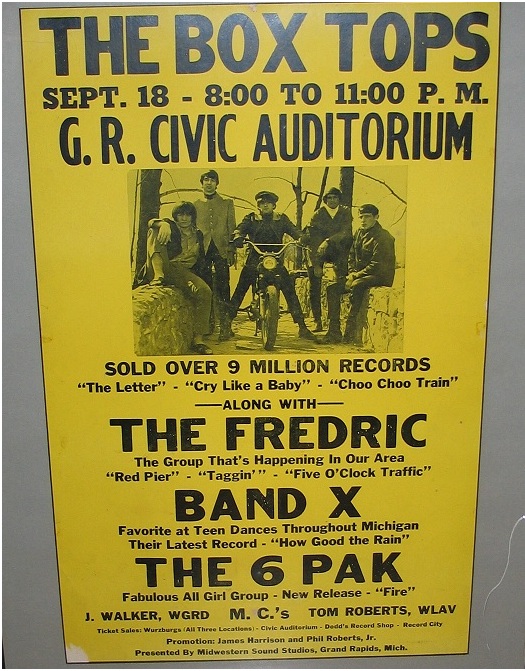
Poster for the Boxtops concert featuring the Fredric, Band X and the 6 Pak

This is a page from the brochure for the September 18, 1968 Boxtops concert at the Civic Auditorium, which featured the 6 Pak as the opening act.
Sadly, Phil lost his entire investment in this show when 5,433.80 in gate receipts were embezzled by Jim Harrison, according to a September 25, 1968 Grand Rapids Press article. Harrison was supposed to deposit the gate receipts in the bank, but instead, he fled town with his wife and his five year old daughter. Roberts never heard back from Harrison.
Cindy: “This concert was a big deal to us. We wanted to get our hair done but that meant that we had to leave school early. They made all six of us serve a detention in order to get the time off. Paul Arbanas arranged for us to be picked up at school in a limousine. The driver took us all around the school parking lot. The Boxtops used some of our equipment for their performance. They used our sound system and my drums, because our gear was better quality than the rented stuff that was on stage. We played a medley of the Beatle’s ‘Sergeant Pepper’s Lonely Heart Club Band’ along with ‘A Little Help From My Friends’ as well as the Grassroot’s ’Midnight Confessions.’ ”
Marcia recalls being on stage at the Boxtops concert: “I can still see the curtains opening and the big room with the huge audience sitting in the dark. The first song was very slow and seemingly endless. Yet I have no recollection of how many songs we did or which ones they were, other than that first one! And I have no idea in what order the bands performed, other than the Boxtops being last, of course.”
Andrea provided the following recollection: “as the curtain opened in front of us I played a glissando on my organ, running my hand up and down the keyboard, trying to accentuate the excitement during the beginning of our performance. We opened with the Glen Campbell hit, ‘By the Time I Get to Phoenix, ‘ which Marcia sang.”
Grand Rapids Press reporter Anne Wilford wrote an article concerning this concert, which included this concise summary of the 6 Pak’s accomplishments:

From the fall of 1968 to the summer of 1969, the 6 Pak kept so busy with their band work that they missed many school functions such as sporting events and dances. But they did take a weekend off to attend their Homecoming football game and dance in the fall of 1968, partially because Rochelle was voted in as queen of this celebration. They all wanted to be there for her.
During the last nine months that they were together, their jobs were primarily located at teenage nightclubs and college dances.
In 1967, the band began working for the sum of 25.00 for the entire group, but they gradually worked their way up to a maximum of 200.00 per night, which was typical pay for a nightclub band in 1975. Unfortunately, wages for local musicians have not generally increased since the days of the 6 Pak.
In early 1969, Paul and Danny proposed a plan to the girls which involved bringing the band to California in an attempt to promote their success. “But we knew we had to go to college and that was all there was to it.” Without many tears or other emotional fanfare, the 6 Pak disbanded as they all graduated from West Catholic in the spring of 1969. Their last performance was at Grand Valley State College, in late May.
Marcia left Grand Rapids in the fall to attend college in Detroit. She served as a D.J. at a radio station while she was living there. She moved to California in 1974 and completed her undergraduate degree at the University of California in San Diego, where she still resides. Marcia sings with a group of women on Sunday mornings.
Andrea attended Grand Rapids Junior College and Ferris State College. During her working career she has worked as a dental assistant, and in the retail clothing industry, with Michigan Consolidated Gas for 24 years, and Diocesan Publications for nine years. She has been very active in numerous local business and community leadership roles, as well. Andrea is retired and lives in Peoria, Arizona, and spends her summers in Michigan.
Mary attended Grand Rapids Junior College and owns her own business. She has been self employed for over 30 years in the retail clothing industry.
Cindy went to Chic University of Cosmetology and became a beautician. She has owned and operated her own hair salon for over 30 years.
Rochelle went to nursing school and became an R.N. She worked in Grand Rapids for one year and then moved to Kansas City, before returning to Grand Rapids.
Karen moved to Denver and lived there for awhile. She worked for years as a golf professional in Atlanta, Detroit and Greenville, South Carolina.
The 6 Pak entered the local music scene in early 1967 without hype and pretense. They left it behind in June of 1969, retaining their humility and poise.
As the girls worked at selling the band’s equipment and registered for their college classes, it is likely that they were not focused on summarizing their considerable accomplishments, which were attained in less than two and one half years.
But now, over forty years later, when they recall their achievements, it must seem like a sweet dream that actually came true.
_______________________________________________________________________________
Footnote: There were several female singers performing and recording in Grand Rapids during the 1960s. Some of these talented ladies included Ruth Ann Lubinskas (Scott), Lin Nowicki, Patsy Stevens, Kathy Kahler, Diane Maxim, Cindy Marsh, Mary Rudolph, Sue Greiner, Ann Godfrey, Cheryl Woudstra, Cathy (Gail) Heeringa, Eileen Sarafis, and Trudy and Nancy Westbrook.
I want to extend my appreciation to the 6 Pak women for answering my endless questions.
The Six Pak is:
Mary Arbanas- rhythm guitar
Marcia Boruta- lead singer and tambourine
Karen Delehanty. -lead guitar
Rochelle Geluso Mudrey- bass guitar
Cindy Grey Obetts- drums
Andrea Halas Sullivan- keyboards [Andrea recalls: “we called it an organ back then”]

Thanks to Doug Taylor for introducing me to the 6 Pak and for posting this article on the website. It’s a hard job and Doug also does a great job of building the website.
Special thanks to Jerry Panek and Matt Weber for refurbishing the 6 Pak source recordings and providing photos and information for this story, as well sharing a deep appreciation for the 6 Pak.
Thanks to Tom Kirby for his ideas and analysis concerning teenage nightclub history.
Thanks to Phil Roberts for clarifying issues pertaining to the Boxtop’s concert which occurred at the Civic Auditorium in September of 1968.
More about the 6 – Pak, click on the link below:
6 – Pak Band Page Link: http://www.westmichmusichystericalsociety.com/six-pack
6/10-7/24

One Response to 6 – Pak (All Girls Band)